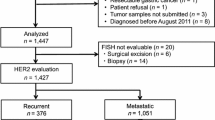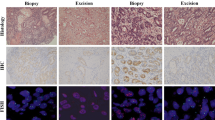Abstract
HER2 protein overexpression and gene amplification are important biomarkers for identifying gastric cancer patients who may respond to HER2-targeted therapy using trastuzumab. The aim of this study was to evaluate the concordance between HER2 protein expression and gene amplification in both surgically resected tumors and matched biopsy specimens of gastric cancer. Formalin-fixed, paraffin-embedded sections of 207 surgically resected tumors and 158 biopsy specimens from 207 cases of invasive intestinal-type gastric cancer were analyzed. Protein expression was assessed using immunohistochemistry and graded by the modified scoring criteria for gastric cancer. Gene amplification was evaluated by fluorescence in situ hybridization (FISH). HER2 overexpression was observed in 17 % of both surgically resected tumors (35/207) and biopsy specimens (26/158). HER2 gene amplification was detected in 31 % (61/200) of surgically resected tumors and 32 % (47/147) of biopsy specimens. Except for immunohistochemistry (IHC) equivocal (2+) cases, the concordance rates between IHC and FISH was 90.9 % in surgically resected tumors and 90.2 % in biopsy specimens. In IHC 2+ cases, the rate of HER2 gene amplification was 56 and 38 % in surgically resected tumors and biopsy specimens, respectively. IHC-FISH discordance was mainly due to intratumoral heterogeneity and low-level gene amplification. The concordance rate of IHC results between surgically resected specimens and the corresponding biopsy specimen was 57.0 % (κ = 0.224), and in discordant cases, HER2 positivity in biopsies and HER2 negativity in surgically resected tumors were most common. The concordance rate of FISH results between surgically resected tumors and biopsy specimens was 72.7 % (κ = 0.313). Polysomy 17 was detected in 5.5 and 7.5 % of surgically resected tumors and biopsy specimens and significantly correlated with IHC score, but polysomy 17 could explain one IHC score 3+ and FISH-negative tumor only. Although high concordance rates between HER2-protein expression and gene amplification were observed in both surgically resected tumors and biopsy specimens, the agreement levels were evaluated to be fair. Polysomy 17 was infrequent and seemed to have limited impact on gastric HER2 testing. Further investigations are required for an appropriate biopsy method to reduce false results of HER2 testing and to clarify the clinical significance of intratumoral heterogeneity in HER2 status.


Similar content being viewed by others
References
Krejs GJ (2010) Gastric cancer: epidemiology and risk factors. Dig Dis 28(4–5):600–603
Scartozzi M et al (2010) Novel perspectives for the treatment of gastric cancer: from a global approach to a personalized strategy. Curr Oncol Rep 12(3):175–185
Bang YJ et al (2010) Trastuzumab in combination with chemotherapy versus chemotherapy alone for treatment of HER2-positive advanced gastric or gastro-oesophageal junction cancer (ToGA): a phase 3, open-label, randomised controlled trial. Lancet 376(9742):687–697
Urano N et al (2006) Overexpression of hypoxia-inducible factor-1 alpha in gastric adenocarcinoma. Gastric Cancer 9(1):44–49
Sakai K et al (1986) Expression of epidermal growth factor receptors on normal human gastric epithelia and gastric carcinomas. J Natl Cancer Inst 77(5):1047–1052
Ishida T et al (1994) Significance of erbB-2 gene product as a target molecule for cancer therapy. Scand J Immunol 39(5):459–466
Tokunaga A et al (1995) Clinical significance of epidermal growth factor (EGF), EGF receptor, and c-erbB-2 in human gastric cancer. Cancer 75(6 Suppl):1418–1425
Yano T et al (2006) Comparison of HER2 gene amplification assessed by fluorescence in situ hybridization and HER2 protein expression assessed by immunohistochemistry in gastric cancer. Oncol Rep 15(1):65–71
Yokota J et al (1988) Genetic alterations of the c-erbB-2 oncogene occur frequently in tubular adenocarcinoma of the stomach and are often accompanied by amplification of the v-erbA homologue. Oncogene 2(3):283–287
Kim JW et al (2012) The prognostic significance of HER2 positivity for advanced gastric cancer patients undergoing first-line modified FOLFOX-6 regimen. Anticancer Res 32(4):1547–1553
Shitara K et al (2013) Prognosis of patients with advanced gastric cancer by HER2 status and trastuzumab treatment. Gastric Cancer 16(2):261–267
Tanner M et al (2005) Amplification of HER-2 in gastric carcinoma: association with Topoisomerase IIalpha gene amplification, intestinal type, poor prognosis and sensitivity to trastuzumab. Ann Oncol 16(2):273–278
Terashima M et al (2012) Impact of expression of human epidermal growth factor receptors EGFR and ERBB2 on survival in stage II/III gastric cancer. Clin Cancer Res 18(21):5992–6000
Kim MA et al (2007) Evaluation of HER-2 gene status in gastric carcinoma using immunohistochemistry, fluorescence in situ hybridization, and real-time quantitative polymerase chain reaction. Hum Pathol 38(9):1386–1393
Matsubara J et al (2008) Impact of insulin-like growth factor type 1 receptor, epidermal growth factor receptor, and HER2 expressions on outcomes of patients with gastric cancer. Clin Cancer Res 14(10):3022–3029
Yan B et al (2010) A study of HER2 gene amplification and protein expression in gastric cancer. J Clin Pathol 63(9):839–842
Yan SY et al (2011) Clinicopathologic significance of HER-2/neu protein expression and gene amplification in gastric carcinoma. World J Gastroenterol 17(11):1501–1506
Lee S et al (2011) Human epidermal growth factor receptor 2 testing in gastric carcinoma: issues related to heterogeneity in biopsies and resections. Histopathology 59(5):832–840
Liu W et al (2012) HER-2/neu overexpression is an independent prognostic factor for intestinal-type and early-stage gastric cancer patients. J Clin Gastroenterol 46(4):e31–e37
Giuffre G et al (2012) HER2 status in unusual histological variants of gastric adenocarcinomas. J Clin Pathol 65(3):237–241
Tsapralis D et al (2012) Human epidermal growth factor receptor-2 gene amplification in gastric cancer using tissue microarray technology. World J Gastroenterol 18(2):150–155
Halon A et al (2012) HER-2 expression in immunohistochemistry has no prognostic significance in gastric cancer patients. Sci World J 2012:941259
Uchino S et al (1993) Overexpression of c-erbB-2 protein in gastric cancer. Its correlation with long-term survival of patients. Cancer 72(11):3179–3184
Dang HZ, Yu Y, Jiao SC (2012) Prognosis of HER2 over-expressing gastric cancer patients with liver metastasis. World J Gastroenterol 18(19):2402–2407
Jorgensen JT, Hersom M (2012) HER2 as a prognostic marker in gastric cancer—a systematic analysis of data from the literature. J Cancer 3:137–144
Park DI et al (2006) HER-2/neu amplification is an independent prognostic factor in gastric cancer. Dig Dis Sci 51(8):1371–1379
Gomez-Martin C et al (2012) HER2/neu testing for anti-HER2-based therapies in patients with unresectable and/or metastatic gastric cancer. J Clin Pathol 65(8):751–757
Janjigian YY et al (2012) Prognosis of metastatic gastric and gastroesophageal junction cancer by HER2 status: a European and USA International collaborative analysis. Ann Oncol 23(10):2656–2662
Kimura M et al (2004) A proposal for diagnostically meaningful criteria to classify increased epidermal growth factor receptor and c-erbB-2 gene copy numbers in gastric carcinoma, based on correlation of fluorescence in situ hybridization and immunohistochemical measurements. Virchows Arch 445(3):255–262
Park YS et al (2012) Comprehensive analysis of HER2 expression and gene amplification in gastric cancers using immunohistochemistry and in situ hybridization: which scoring system should we use? Hum Pathol 43(3):413–422
Hofmann M et al (2008) Assessment of a HER2 scoring system for gastric cancer: results from a validation study. Histopathology 52(7):797–805
Grabsch H et al (2010) HER2 expression in gastric cancer: Rare, heterogeneous and of no prognostic value - conclusions from 924 cases of two independent series. Cell Oncol 32(1–2):57–65
Kunz PL et al (2012) HER2 expression in gastric and gastroesophageal junction adenocarcinoma in a US population: clinicopathologic analysis with proposed approach to HER2 assessment. Appl Immunohistochem Mol Morphol 20(1):13–24
Ruschoff J et al (2010) HER2 diagnostics in gastric cancer-guideline validation and development of standardized immunohistochemical testing. Virchows Arch 457(3):299–307
Landis JR, Koch GG (1977) The measurement of observer agreement for categorical data. Biometrics 33(1):159–174
Tafe LJ et al (2011) Human epidermal growth factor receptor 2 testing in gastroesophageal cancer: correlation between immunohistochemistry and fluorescence in situ hybridization. Arch Pathol Lab Med 135(11):1460–1465
Garcia I et al (2003) Clinical significance of the epidermal growth factor receptor and HER2 receptor in resectable gastric cancer. Ann Surg Oncol 10(3):234–241
Jaehne J et al (1992) Expression of Her2/neu oncogene product p185 in correlation to clinicopathological and prognostic factors of gastric carcinoma. J Cancer Res Clin Oncol 118(6):474–479
Im SA et al (2011) Clinicopathologic characteristics of patients with stage III/IV (M(0)) advanced gastric cancer, according to HER2 status assessed by immunohistochemistry and fluorescence in situ hybridization. Diagn Mol Pathol 20(2):94–100
Kim KC et al (2011) Evaluation of HER2 protein expression in gastric carcinomas: comparative analysis of 1,414 cases of whole-tissue sections and 595 cases of tissue microarrays. Ann Surg Oncol 18(10):2833–2840
Tsuda H et al (2001) Detection of HER-2/neu (c-erb B-2) DNA amplification in primary breast carcinoma. Interobserver reproducibility and correlation with immunohistochemical HER-2 overexpression. Cancer 92(12):2965–2974
Yang J et al (2012) Intratumoral heterogeneity determines discordant results of diagnostic tests for human epidermal growth factor receptor (HER) 2 in gastric cancer specimens. Cell Biochem Biophys 62(1):221–228
Yan B et al (2011) Dual-colour HER2/chromosome 17 chromogenic in situ hybridisation assay enables accurate assessment of HER2 genomic status in gastric cancer and has potential utility in HER2 testing of biopsy samples. J Clin Pathol 64(10):880–883
Ruschoff J et al (2012) HER2 testing in gastric cancer: a practical approach. Mod Pathol 25(5):637–650
Warneke VS et al (2013) Her2/neu testing in gastric cancer: evaluating the risk of sampling errors. Ann Oncol 24(3):725–733
Guarneri V et al (2008) Comparison of HER-2 and hormone receptor expression in primary breast cancers and asynchronous paired metastases: impact on patient management. Oncologist 13(8):838–844
Pusztai L et al (2010) Estrogen and HER-2 receptor discordance between primary breast cancer and metastasis. Oncologist 15(11):1164–1168
Wolff AC et al (2013) Recommendations for human epidermal growth factor receptor 2 testing in breast cancer: American Society of Clinical Oncology/College of American Pathologists clinical practice guideline update. J Clin Oncol 31(31):3997–4013
Bozzetti C et al (2011) Comparison of HER2 status in primary and paired metastatic sites of gastric carcinoma. Br J Cancer 104(9):1372–1376
Fassan M et al (2012) Human epithelial growth factor receptor 2 (HER2) status in primary and metastatic esophagogastric junction adenocarcinomas. Hum Pathol 43(8):1206–1212
Acknowledgments
This study was supported in part by Abbott Japan Co. Ltd, Tokyo, Japan, and the National Cancer Center Research and Development Fund. We thank Sachiko Miura, M.T., and Chizu Kina, M. T., for their technical assistance.
Conflict of interest
This study was supplied in part by Abbott Japan Co. Ltd.
Author information
Authors and Affiliations
Corresponding author
Rights and permissions
About this article
Cite this article
Yoshida, H., Yamamoto, N., Taniguchi, H. et al. Comparison of HER2 status between surgically resected specimens and matched biopsy specimens of gastric intestinal-type adenocarcinoma. Virchows Arch 465, 145–154 (2014). https://doi.org/10.1007/s00428-014-1597-3
Received:
Revised:
Accepted:
Published:
Issue Date:
DOI: https://doi.org/10.1007/s00428-014-1597-3




